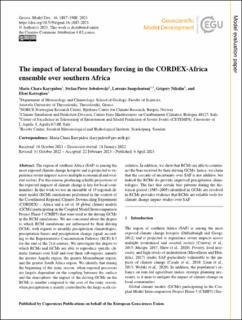| dc.contributor.author | Karypidou, Maria Chara | |
| dc.contributor.author | Sobolowski, Stefan Pieter | |
| dc.contributor.author | Sangelantoni, Lorenzo | |
| dc.contributor.author | Nikulin, Grigory | |
| dc.contributor.author | Katragkou, Eleni | |
| dc.date.accessioned | 2023-09-20T08:41:49Z | |
| dc.date.available | 2023-09-20T08:41:49Z | |
| dc.date.created | 2023-06-14T13:37:46Z | |
| dc.date.issued | 2023 | |
| dc.identifier.citation | Geoscientific Model Development. 2023, 16 (7), 1887-1908. | en_US |
| dc.identifier.issn | 1991-959X | |
| dc.identifier.uri | https://hdl.handle.net/11250/3090706 | |
| dc.description.abstract | The region of southern Africa (SAF) is among the most exposed climate change hotspots and is projected to experience severe impacts across multiple economical and societal sectors. For this reason, producing reliable projections of the expected impacts of climate change is key for local communities. In this work we use an ensemble of 19 regional climate model (RCM) simulations performed in the context of the Coordinated Regional Climate Downscaling Experiment (CORDEX) – Africa and a set of 10 global climate models (GCMs) participating in the Coupled Model Intercomparison Project Phase 5 (CMIP5) that were used as the driving GCMs in the RCM simulations. We are concerned about the degree to which RCM simulations are influenced by their driving GCMs, with regards to monthly precipitation climatologies, precipitation biases and precipitation change signal, according to the Representative Concentration Pathway (RCP) 8.5 for the end of the 21st century. We investigate the degree to which RCMs and GCMs are able to reproduce specific climatic features over SAF and over three sub-regions, namely the greater Angola region, the greater Mozambique region, and the greater South Africa region. We identify that during the beginning of the rainy season, when regional processes are largely dependent on the coupling between the surface and the atmosphere, the impact of the driving GCMs on the RCMs is smaller compared to the core of the rainy season, when precipitation is mainly controlled by the large-scale circulation. In addition, we show that RCMs are able to counteract the bias received by their driving GCMs; hence, we claim that the cascade of uncertainty over SAF is not additive, but indeed the RCMs do provide improved precipitation climatologies. The fact that certain bias patterns during the historical period (1985–2005) identified in GCMs are resolved in RCMs provides evidence that RCMs are reliable tools for climate change impact studies over SAF. | en_US |
| dc.language.iso | eng | en_US |
| dc.rights | Navngivelse 4.0 Internasjonal | * |
| dc.rights.uri | http://creativecommons.org/licenses/by/4.0/deed.no | * |
| dc.title | The impact of lateral boundary forcing in the CORDEX-Africa ensemble over southern Africa | en_US |
| dc.title.alternative | The impact of lateral boundary forcing in the CORDEX-Africa ensemble over southern Africa | en_US |
| dc.type | Journal article | en_US |
| dc.type | Peer reviewed | en_US |
| dc.rights.holder | © Author(s) 2023 | en_US |
| dc.description.version | publishedVersion | en_US |
| cristin.ispublished | true | |
| cristin.fulltext | original | |
| cristin.qualitycode | 2 | |
| dc.identifier.doi | 10.5194/gmd-16-1887-2023 | |
| dc.identifier.cristin | 2154493 | |
| dc.source.journal | Geoscientific Model Development | en_US |
| dc.source.volume | 16 | en_US |
| dc.source.issue | 7 | en_US |
| dc.source.pagenumber | 1887-1908 | en_US |

